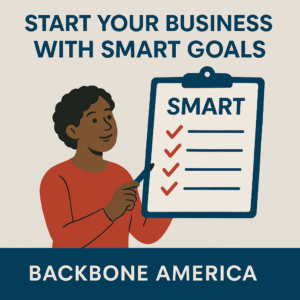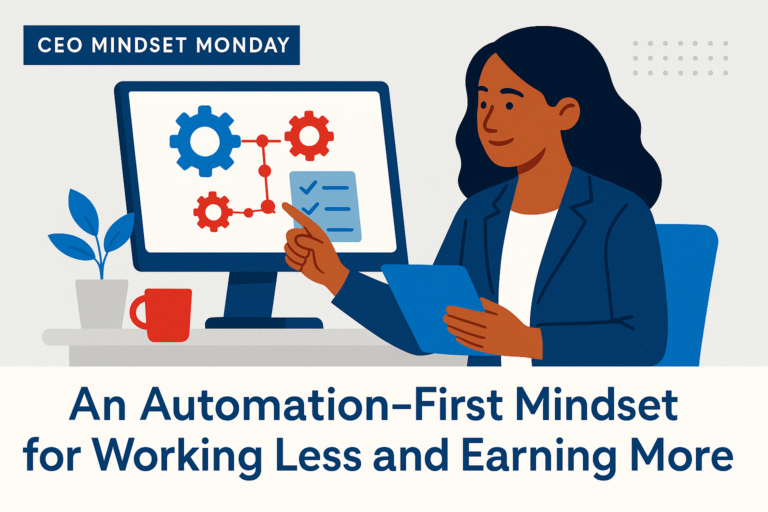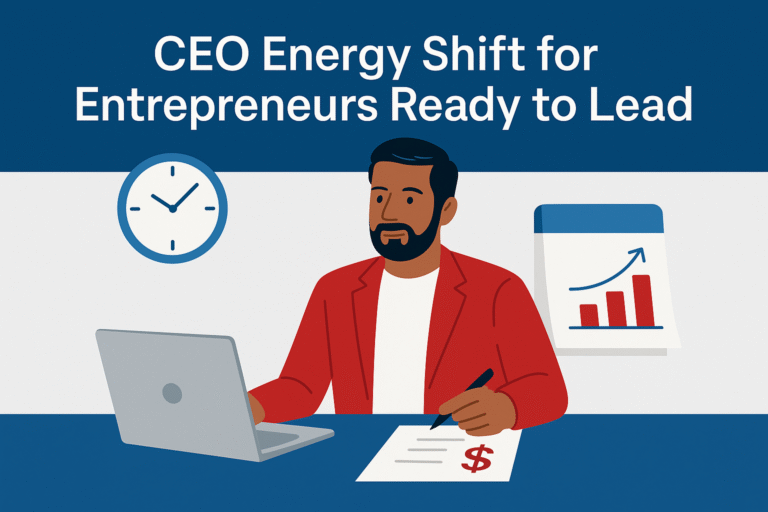CEO Mindset Monday
Leadership fears are one of the biggest hidden obstacles new entrepreneurs face. Most people assume the hardest part of starting a business is figuring out marketing or how to make money—but for many first-time founders, it’s leadership fears that stop them before they ever really begin.
These fears aren’t loud or obvious.
They sneak in quietly—through delays, over-planning, and constant comparison. Sometimes they show up as hesitation to make key decisions or avoidance of any choice that might shake things up. You stay stuck not because you don’t know what to do, but because fear convinces you that the timing isn’t right, or that you’re not ready yet.
You hold on to what’s familiar, even when it’s no longer serving the business—or your purpose. You stay too long in roles, offers, platforms, or pricing models you’ve outgrown because letting go feels too risky. It’s not that you can’t lead—it’s that your leadership fears have convinced you that playing it safe is smarter than moving forward.
I see it in myself, especially when it comes to money decisions. Every spending choice feels like a test. I ask myself, “Should I spend this now? Can I hold onto the cash a little longer?” Even when I know the investment will move my business forward, leadership fears whisper that it’s safer to hold back.
I’ve wasted time trying to do things myself—tasks I knew I should’ve outsourced—because I was scared of making the wrong move. But the truth is, playing small doesn’t protect your business. It just slows it down.
What Leadership Fears Look Like for Entrepreneurs
Leadership fears are sneaky—but they’re also incredibly common. If you’ve ever second-guessed a decision, delayed a launch, or hesitated to share your offer, you’re not alone. These are the quiet doubts that almost every founder faces in the beginning.
The good news? These fears don’t mean you’re not ready. They mean you’re stepping into something real.

I felt like an imposter when I first started, even though I had years of experience in business advising and automation. Because I hadn’t made sales yet, I questioned whether I had the right to call myself a business owner. But I did. I had the knowledge. I had the systems. And I had already created the business—whether or not the revenue had shown up yet.
Once I realized that leadership fears were just part of the journey—not a sign to stop—I started to move differently. I stopped waiting to feel “ready” and started practicing leadership instead.
That’s the shift.
When you name what’s holding you back, you get to lead anyway. You don’t have to be fearless—you just have to keep choosing to show up.
Why Leadership Fears Run So Deep
Leadership fears don’t come out of nowhere. They’re shaped by the environments we’ve worked in, the roles we’ve played, and the stories we’ve been told about what it means to lead.
Most entrepreneurs didn’t start out calling the shots. We were employees first—trained to execute someone else’s plan, follow someone else’s process, and wait for permission before moving forward. That mindset doesn’t disappear the day you launch your business. Instead, it shows up when you hesitate to make decisions without input. It lingers when you second-guess your instincts.
Starting a business means stepping out of the employee space and taking on the unfamiliar role of business ownership. And without that structure, it’s easy to question everything.
Leadership fears thrive in uncertainty.

Here’s the truth: fear doesn’t make you a failure. It’s an emotion, not a verdict. You may not always be able to control when it shows up, but you can control how you move forward.
Many of us have spent years working in roles where the goals were already defined. We were given a structure, a scope, and clear expectations. That doesn’t mean we weren’t capable—but it does mean we weren’t expected to lead the full vision ourselves.
When you become a business owner, that shifts. You’re not just completing tasks—you’re setting direction. You’re deciding what matters, where to invest, and when to pivot. Even with all the planning tools and expert advice in the world, there’s still a moment where you have to trust yourself to lead.
I’ve felt that edge. For me, it wasn’t about whether I had the skills—I knew I did. It was about giving up the comfort of knowing exactly what was expected of me. There’s a kind of safety in employment that disappears when you’re the one creating the expectations from scratch. That’s where leadership fears start to creep in.
The thing about leadership is it doesn’t begin when fear goes away. And it doesn’t require perfection.
It begins when you decide to keep going—even when mistakes happen. Even when fear is present.
Leadership begins when you choose to lead anyway.
How Fear Becomes a Silent Business Killer
Leadership fears don’t always stop you outright. More often, they slow you down in ways that look responsible or strategic on the surface—but quietly sabotage your momentum underneath.
- You undercharge because you’re afraid people won’t pay.
- You over-deliver to prove you’re worth it.
- You keep “getting ready” to launch instead of actually launching.
You spend hours perfecting graphics or reworking copy when you already know what you’re offering. You second-guess decisions you’ve already made. You avoid visibility because you’re waiting to feel more confident before you show your face or raise your hand.
All of it looks like effort. But underneath, it’s fear.
I’ve seen how this plays out in my own business. I’ve held back on spending money—even when I knew an investment would move me forward—because I was afraid of getting it wrong. I’ve delayed hiring help, even when I didn’t have the time or energy to do everything myself, simply because the idea of letting go felt too risky or costly
But leadership means choosing what moves the business forward—not what makes you feel most comfortable in the moment.

When fear is running the show, you end up staying small. You hold back offers. You miss opportunities. You say yes to clients who drain your energy instead of protecting your time for the people you’re meant to serve.
And worst of all, the people who need your help can’t find you—because fear has kept you in hiding.
It doesn’t have to be that way. Once you recognize what fear is costing you, you can make different choices. And even use that fear to fuel your business.
You Don’t Need Permission to Lead Your Business
You can register your business, get your license, and even set up your website—but none of those things guarantee you’ll feel ready to lead. That’s the part no one talks about. The paperwork can make it official, but it doesn’t always make it real to you—not at first.
Waiting for clarity, confidence, or external validation will keep you stuck longer than any technical challenge ever will. You get stronger as you act—as you make decisions, evaluate results, and keep going. The confidence comes after the commitment, not before.
For me, this shows up most often with money decisions. When fear is in the room, I want to wait. I want to hold on to what I have, even when I know that investing in the right tools or support could move my business forward.

- If I spend this money, will it help me move toward my goals?
- Is it a distraction—or a step forward?
- What happens to my business if I don’t spend this money right now?
And just as important: If I do spend it, do I have the time and capacity to take full advantage of the results I’m trying to create? That’s a big one, because I love technology.
Those questions help me lead, even when leadership fears are still lingering in the background.
You don’t need to feel “ready” to lead your business. You just need to get honest about what’s keeping you from taking the next step—and decide to lead anyway.
Leadership Is a Daily Decision, Not a Title
Leadership isn’t a one-time milestone—it’s a practice.
You don’t have to wait until you “feel like a CEO” to start acting like one. You lead by showing up, even when it’s uncomfortable. It’s something you step into every time you quote your rate, send a follow-up email, or say no to a client who isn’t the right fit.
When I worked at the SBDC, I didn’t get to choose who I served. I worked with everyone—no matter their stage, no matter their level of readiness. And I saw it all: people who had solid plans and people who were running on what I call “hopium.” They hoped things would work out, but weren’t willing to build the systems, structure, or clarity needed to make that hope real.
That experience shaped how I work now.
My Done-for-You services aren’t for everyone—and that’s intentional. I’ve built in applications because I no longer lead from fear. I don’t accept misaligned clients just to feel useful or busy. I serve from a place of strength. That’s leadership.
And that’s what I want for you.
The founder journey will always involve fear. It’s part of doing something that stretches you. But fear doesn’t have to lead. When you feel it rise, that’s not a sign to stop—it’s a signal that growth is happening.
You don’t need to wait for permission. You don’t need to have all the answers.
You just need to lead—one decision at a time.






